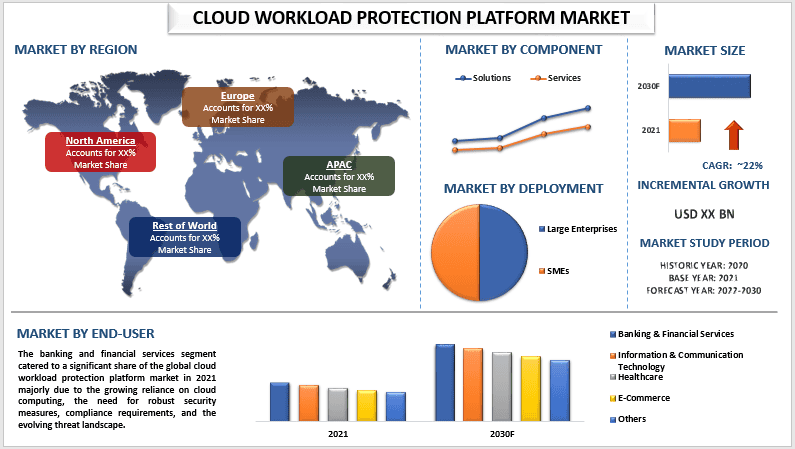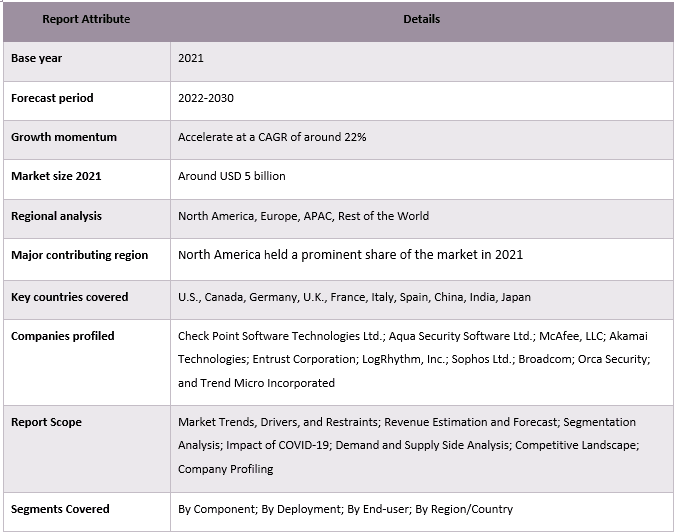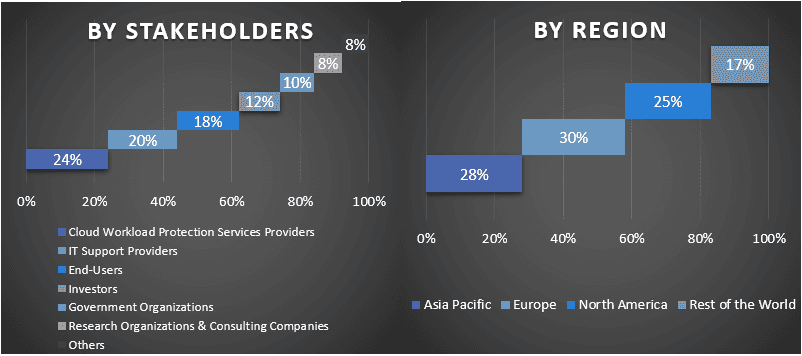- Home
- About Us
- Industry
- Services
- Reading
- Contact Us
Cloud Workload Protection Platform Market : Current Analysis and Forecast (2022-2030)
Emphasis on Component (Solutions and Services); Deployment (On-Premises and Cloud); End-User (Banking & Financial Services, Information & Communication Technology, Healthcare, E-Commerce, and Others); and Region/Country

The Cloud Workload Protection Platform Market stood at around 5 billion in 2021 and is expected to grow at a steady rate of around 22% owing to the increase in the adoption of multi-cloud strategies among enterprises. A cloud workload protection platform is a comprehensive security solution designed to protect workloads deployed in cloud environments. As organizations increasingly rely on cloud computing to store and process their data, it becomes crucial to ensure the security and integrity of these workloads. A CWPP offers a range of security features and functionalities that are specifically tailored to address the unique challenges and risks associated with cloud workloads. Moreover, the increasing need to secure enterprise workloads from unauthorized strikes, and centralized policy enforcement are other factors helping the market to grow. Additionally, the increasing number of cyber-attacks across various industries is one of the most prominent factors contributing to the growth of the market. For instance, according to the 2022 IBM security report, there will be a surge in various cyberattacks between 2020-2021. Notably, those caused by exploiting vulnerabilities have increased by 33%.
Some of the major players operating in the market include Check Point Software Technologies Ltd.; Aqua Security Software Ltd.; McAfee, LLC; Akamai Technologies; Entrust Corporation; LogRhythm, Inc.; Sophos Ltd.; Broadcom; Orca Security; and Trend Micro Incorporated. Several M&As along with partnerships have been undertaken by these players to facilitate customers with hi-tech and innovative products/technologies.
Insights Presented in the Report
“Amongst component, the solutions segment is expected to grow at a robust CAGR during the forecast period”
Based on component, the market is segmented into solutions and services. The solutions segment is expected to grow at a prominent CAGR during the forecasted period owing to the widespread adoption of cloud computing, the evolving threat landscape, compliance requirements, and the complexity of modern cloud infrastructures. By providing specialized security capabilities tailored for cloud workloads, cloud workload protection platform solutions enable organizations to enhance their security posture, detect and respond to threats effectively, and meet regulatory obligations in an increasingly digital and interconnected world.
“Amongst deployment, the cloud segment is expected to grow at a robust CAGR”
On the basis of deployment, the market is bifurcated into on-premises and cloud. The demand for cloud deployment is increasing mainly owing to the need for robust and specialized security solutions in the cloud. These platforms offer comprehensive protection, address the complexities of cloud environments, ensure compliance with regulations, and defend against evolving cyber threats. As organizations continue to embrace cloud computing, the importance of cloud workload protection platform solutions will only grow, making them a vital component of modern cloud security strategies.
“North America held a significant share of the global cloud workload protection platform market in 2021”
North America held a significant share of the global cloud workload protection platform market in 2021. The increasing demand for cloud workload protection platforms in North America can be attributed to the widespread adoption of cloud computing, the need for robust security measures, regulatory compliance requirements, and the evolving threat landscape. These platforms enable organizations to secure their cloud-based workloads, protect sensitive data, meet compliance obligations, and stay resilient against a rapidly evolving cyber threat landscape.
Cloud Workload Protection Platform Market Report Coverage

Reasons to buy this report:
- The study includes market sizing and forecasting analysis validated by authenticated key end-user experts.
- The report presents a quick review of overall end-user performance at one glance.
- The report covers an in-depth analysis of prominent end-user peers with a primary focus on key business financials, product portfolios, expansion strategies, and recent developments.
- Detailed examination of drivers, restraints, key trends, and opportunities prevailing in the end-user.
- The study comprehensively covers the market across different segments.
- Deep dive regional level analysis of the end-user.
Customization Options:
The global cloud workload protection platform market can further be customized as per the requirement or any other market segment. Besides this, UMI understands that you may have your own business needs, hence feel free to contact us to get a report that completely suits your requirements.
Table of Content
Research Methodology for the Cloud Workload Protection Platform Market Analysis (2022-2030)
Analyzing the historical market, estimating the current market, and forecasting the future market of the global cloud workload protection platform market were the three major steps undertaken to create and analyze the adoption of cloud workload protection platforms in major regions globally. Exhaustive secondary research was conducted to collect the historical market numbers and estimate the current market size. Secondly, to validate these insights, numerous findings and assumptions were taken into consideration. Moreover, exhaustive primary interviews were also conducted, with end-user experts across the value chain of the global cloud workload protection platform market. Post assumption and validation of market numbers through primary interviews, we employed a top-down/bottom-up approach to forecasting the complete market size. Thereafter, market breakdown and data triangulation methods were adopted to estimate and analyze the market size of segments and sub-segments of the end-user pertains to. Detailed methodology is explained below:
Analysis of Historical Market Size
Step 1: In-Depth Study of Secondary Sources:
Detail secondary study was conducted to obtain the historical market size of the cloud workload protection platform market through company internal sources such as annual reports & financial statements, performance presentations, press releases, etc., and external sources including journals, news & articles, government publications, competitor publications, sector reports, third-party database, and other credible publications.
Step 2: Market Segmentation:
After obtaining the historical market size of the cloud workload protection platform market, we conducted a detailed secondary analysis to gather historical market insights and share for different segments & sub-segments for major regions. Major segments are included in the report as component, deployment, and end-user. Further country-level analyses were conducted to evaluate the overall adoption of testing models in that region.
Step 3: Factor Analysis:
After acquiring the historical market size of different segments and sub-segments, we conducted a detailed factor analysis to estimate the current market size of the cloud workload protection platform market. Further, we conducted factor analysis using dependent and independent variables such as component, deployment, and end-user of the cloud workload protection platform market. A thorough analysis was conducted for demand and supply-side scenarios considering top partnerships, mergers and acquisitions, business expansion, and product launches in the cloud workload protection platform market sector across the globe.
Current Market Size Estimate & Forecast
Current Market Sizing: Based on actionable insights from the above 3 steps, we arrived at the current market size, key players in the global cloud workload protection platform market, and market shares of the segments. All the required percentage shares split and market breakdowns were determined using the above-mentioned secondary approach and were verified through primary interviews.
Estimation & Forecasting: For market estimation and forecast, weights were assigned to different factors including drivers & trends, restraints, and opportunities available for the stakeholders. After analyzing these factors, relevant forecasting techniques i.e., the top-down/bottom-up approach were applied to arrive at the market forecast for 2030 for different segments and sub-segments across the major markets globally. The research methodology adopted to estimate the market size encompasses:
- The end-users market size, in terms of revenue (USD) and the adoption rate of the cloud workload protection platform market across the major markets domestically
- All percentage shares, splits, and breakdowns of market segments and sub-segments
- Key players in the global cloud workload protection platform market in terms of products offered. Also, the growth strategies adopted by these players to compete in the fast-growing market
Market Size and Share Validation
Primary Research: In-depth interviews were conducted with the Key Opinion Leaders (KOLs) including Top Level Executives (CXO/VPs, Sales Head, Marketing Head, Operational Head, Regional Head, Country Head, etc.) across major regions. Primary research findings were then summarized, and statistical analysis was performed to prove the stated hypothesis. Inputs from primary research were consolidated with secondary findings, hence turning information into actionable insights.
Split of Primary Participants in Different Regions

Market Engineering
The data triangulation technique was employed to complete the overall market estimation and to arrive at precise statistical numbers for each segment and sub-segment of the global cloud workload protection platform market. data was split into several segments & sub-segments post studying various parameters and trends in the areas of the component, deployment, and end-user in the global cloud workload protection platform market.
The main Objective of the Global Cloud Workload Protection Platform Market Study
The current & future market trends of the global cloud workload protection platform market were pinpointed in the study. Investors can gain strategic insights to base their discretion for investments on the qualitative and quantitative analysis performed in the study. Current and future market trends determined the overall attractiveness of the market at a regional level, providing a platform for the industrial participant to exploit the untapped market to benefit from a first-mover advantage. Other quantitative goals of the studies include:
- Analyze the current and forecast market size of the cloud workload protection platform market in terms of value (USD). Also, analyze the current and forecast market size of different segments and sub-segments
- Segments in the study include areas of the component, deployment, and end-user
- Define and analysis of the regulatory framework for the cloud workload protection platform industry
- Analyze the value chain involved with the presence of various intermediaries, along with analyzing customer and competitor behaviors of the industry
- Analyze the current and forecast market size of the cloud workload protection platform market for the major region
- Major countries of regions studied in the report include Asia Pacific, Europe, North America, and the Rest of the World
- Company profiles of the cloud workload protection platform market and the growth strategies adopted by the market players to sustain in the fast-growing market
- Deep dive regional level analysis of the end-user
Related Reports
Customers who bought this item also bought










